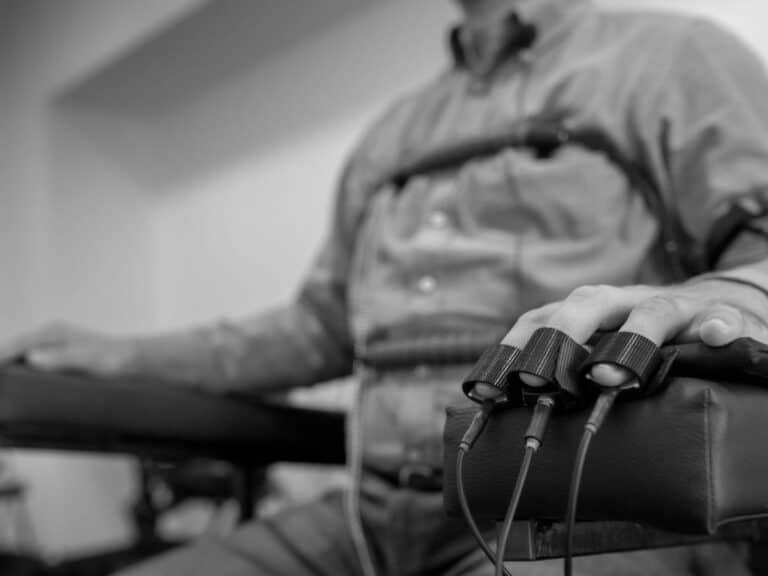The Polygraph Test Process: What to Expect
Despite how TV shows and movies depict it, a polygraph exam does not begin and end with the subject answering yes or no questions asked by the polygrapher. There are many other things that happen before, during and after a lie detector test, and knowing them can make polygraphy less nerve-racking.
A polygraph consists of 3 stages, namely the pre-test phase, test or in-test phase and post-test phase. The pre-test phase is the longest part of a polygraph exam as it involves orienting the subject by the examiner. The test phase where the actual exam happens is the shortest part. It is then followed by the post-test phase where the polygrapher creates the report.
Terrified that the polygraph examiner will accuse you of lying on the spot just like in popular media? Read on.
Below, you will learn about the different things that happen during a polygraph so that you can have a much better idea of what to expect before, while and after you are strapped to a polygraph machine.
The Polygraph Pre-Test Phase
Of the 3 distinct stages of a polygraph test, the longest is the pre-test phase. So much so that it can take anywhere from 45 to 90 minutes to complete. Let’s put that into context much better to give you an idea of just how long the pre-test phase is: on average, the entire lie detector exam can be up to 2 to 3 hours long.
During the pre-test phase, the examinee will discuss with the examiner just about anything there is to know about the lie detector test — what it is, how it’s conducted, what goes on during the procedure, etc. The machine itself will also be talked about, including its various sensors that will be attached to the examinee’s body and the function of each.
It’s also while this initial phase of the exam is in motion when the examiner will ensure that the subject knows the reason for his or her being asked to undergo a lie detector test.
Certain things can make a person unsuitable to undergo a polygraph examination.
Physiological and psychological conditions such as high blood pressure, respiratory illnesses, anxiety and PTSD, can affect the result of the test. The same is true for certain medications, prescription and OTC alike. It’s because of this why the examiner will try to establish the examiner’s physical and mental status during the pre-test phase.
The core of any polygraph testing is the question and answer portion where the examiner asks the subject various questions answerable with either a yes or no.
Coming immediately after the pre-test phase, the said stage will be discussed in a few — don’t stop reading!
In the pre-test phase, the examinee will be given the opportunity to ask the polygraph examiner questions. Since the goal of the pre-test phase is to arm the individual who is about to undergo a lie detector test with as much information as possible, answering any pressing question the examinee has in his or her mind is imperative.
There’s one more very important thing that happens during the pre-test phase of a polygraph test: the examiner’s formulation of the questions that will be asked throughout the test phase.
The Polygraph Test Phase
It’s during the test phase when the question and answer portion happens. It’s also the stage where the examinee tends to feel stressed and anxious the most. After all, the majority of crime drama TV shows and movies present this stage only, thus giving everyone the impression that a lie detector test is all about putting the subject under a microscope.
Various types of questions will be asked by the examiner, not just crime-related ones.
As a matter of fact, some of the questions should not make you feel attacked or threatened. Are you called (your name)? Are you sitting down right now? Is today Wednesday?
These questions are referred to as irrelevant questions. Just like what the name suggests, they have nothing to do with the crime being investigated or the job you are applying for. Irrelevant questions do not cause you to lie or feel uncomfortable because they are designed to let the examiner have a peek at your vitals when you’re relaxed or being truthful.
And then there are also control questions — questions that are meant to increase your stress levels because they can be challenging to answer and, in most instances, can force you to lie.
Have you ever stolen something? Have you ever betrayed someone? Have you ever lied to a loved one?
By asking both irrelevant questions and control questions, the examiner can have an idea of what your physiologic processes are like whenever you’re telling the truth and speaking a lie.
There’s a third set of questions asked by the examiner during a lie detector exam: relevant questions. The name pretty much suggests that they are those that have something to do with the reason for you being subjected to a polygraph test. And when answering them, honesty is the best policy — especially if you want to pass.
But keep in mind that even some truthful people end up failing their lie detector examination.
During the test phase, by the way, you will be hooked up to the polygraph machine by means of its various sensors, which makes it possible for your vitals to be recorded as you are being asked yes or no questions.
The Polygraph Post-Test Phase
The last stage of a lie detector test is referred to as the post-test phase. During this phase, the examiner will remove the different sensors attached to your body one by one.
Addressing any additional questions or concerns by the subject is also another purpose of the post-test phase.
Before the examinee leaves the testing center or the room in the workplace or police station where the examination was conducted, the one who administered the test will provide an oral report of the examination and not the result. That’s because the examiner will have to spend some time taking a look at the chart beforehand.
The written report, on the other hand, is usually sent to the examinee or the individual who required the polygraph test after some time. In many instances, a written report is available 24 hours after the exam.
A polygraph result can be no deception indicated, deception indicated and inconclusive.
Simply put, no deception indicated means that the examinee was completely truthful in his or her responses to the questions during the lie detector test. So, in other words, he or she passed the test. But in some cases, a deceitful person also passes the exam with flying colors. The result, in this example, is what’s referred to as a false negative.
Deception indicated, on the other hand, means that the subject failed the polygraph exam — he or she was being dishonest during the question and answer portion of the test.
The result of a deceitful individual beating the polygraph exam is called a false negative.
Meanwhile, an inconclusive result means that the examiner was unable to come up with a definite diagnosis. Needless to say, he or she failed to determine the truthfulness of the subject based on the chart.
Just Before You Head to the Testing Center
Refrain from assuming that the examiner will hook you up to the polygraph machine and ask you various crime-related yes or no questions as soon as you step foot in the exam room.
Before that happens, you will be oriented about how the lie detector test will go as well as how the polygraph machine works. The examiner will also tell you about your constitutional rights, such as seeking legal counsel and refusing to take the test, and establish your physical and mental status, among many other things.
With fewer uncertainties and doubts about taking a polygraph exam, you can avoid feeling unnecessarily stressed and anxious, which can actually affect the exam’s result.
Related Questions
Can you ask the polygraph examiner to repeat the question?
It’s not uncommon for the individual administering the test to repeat each of the various questions 3 to 4 times in order to make sure that the examinee fully comprehends it. It’s perfectly fine for the subject to ask the examiner to repeat the question, sometimes up to 6 times.
How long does a lie detector test result be retained?
The law states that the record of the polygraph examination should be kept for a minimum of 3 years from the date the test was conducted. When used for pre-screening employment purposes, someone who failed the exam may have to wait for a while before retaking it and reapplying for the job.






